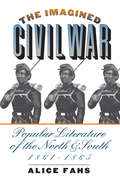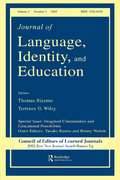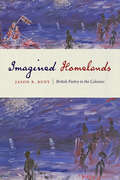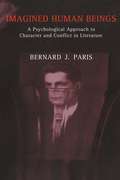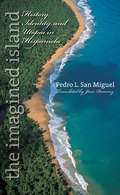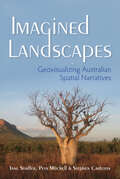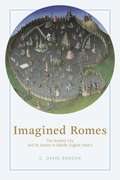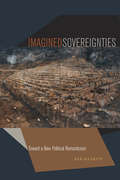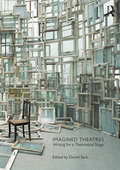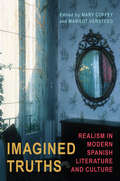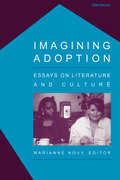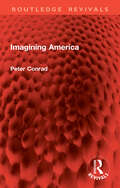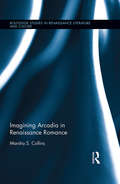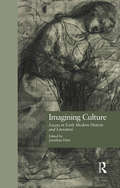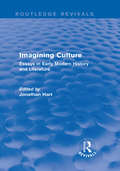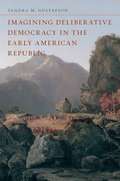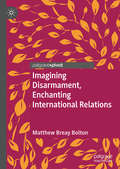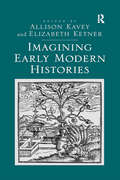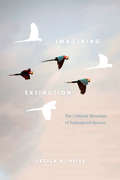- Table View
- List View
The Imagined Civil War
by Alice FahsIn this groundbreaking work of cultural history, Alice Fahs explores a little-known and fascinating side of the Civil War--the outpouring of popular literature inspired by the conflict. From 1861 to 1865, authors and publishers in both the North and the South produced a remarkable variety of war-related compositions, including poems, songs, children's stories, romances, novels, histories, and even humorous pieces. Fahs mines these rich but long-neglected resources to recover the diversity of the war's political and social meanings.Instead of narrowly portraying the Civil War as a clash between two great, white armies, popular literature offered a wide range of representations of the conflict and helped shape new modes of imagining the relationships of diverse individuals to the nation. Works that explored the war's devastating impact on white women's lives, for example, proclaimed the importance of their experiences on the home front, while popular writings that celebrated black manhood and heroism in the wake of emancipation helped readers begin to envision new roles for blacks in American life. Recovering a lost world of popular literature, The Imagined Civil War adds immeasurably to our understanding of American life and letters at a pivotal point in our history.
Imagined Communities and Educational Possibilities: A Special Issue of the journal of Language, Identity, and Education
by Thomas Ricento Terrence G. WileyImagined Communities and Educational Possibilities focuses on three main themes: imaged communities expand the range of possible selves, technological advances in the last two decades have had a significant impact on what is possible to imagine, and imagination at even the most personal level is related to social ideologies and hegemonies. The diverse studies in this issue demonstrate convincingly that learners and teachers are capable of imagining the world as different from prevailing realities. Moreover, time and energy can be invested to strive for the realization of alternative visions of the future. Research in this special issue suggests that investment in such imagined communities offers intriguing possibilities for social and educational change.
Imagined Homelands: British Poetry in the Colonies
by Jason R. RudyA ground-breaking study of nineteenth-century British colonial poetry.Imagined Homelands chronicles the emerging cultures of nineteenth-century British settler colonialism, focusing on poetry as a genre especially equipped to reflect colonial experience. Jason Rudy argues that the poetry of Victorian-era Australia, New Zealand, South Africa, and Canada—often disparaged as derivative and uncouth—should instead be seen as vitally engaged in the social and political work of settlement. The book illuminates cultural pressures that accompanied the unprecedented growth of British emigration across the nineteenth century. It also explores the role of poetry as a mediator between familiar British ideals and new colonial paradigms within emerging literary markets from Sydney and Melbourne to Cape Town and Halifax. Rudy focuses on the work of poets both canonical—including Tennyson, Browning, Longfellow, and Hemans—and relatively obscure, from Adam Lindsay Gordon, Susanna Moodie, and Thomas Pringle to Henry Kendall and Alexander McLachlan. He examines in particular the nostalgic relations between home and abroad, core and periphery, whereby British emigrants used both original compositions and canonical British works to imagine connections between their colonial experiences and the lives they left behind in Europe.Drawing on archival work from four continents, Imagined Homelands insists on a wider geographic frame for nineteenth-century British literature. From lyrics printed in newspapers aboard emigrant ships heading to Australia and South Africa, to ballads circulating in New Zealand and Canadian colonial journals, poetry was a vibrant component of emigrant life. In tracing the histories of these poems and the poets who wrote them, this book provides an alternate account of nineteenth-century British poetry and, more broadly, of settler colonial culture.
Imagined Human Beings: A Psychological Approach to Character and Conflict in Literature (Literature and Psychoanalysis #2)
by Bernard Jay ParisOne of literature's greatest gifts is its portrayal of realistically drawn characters--human beings in whom we can recognize motivations and emotions. In Imagined Human Beings, Bernard J. Paris explores the inner conflicts of some of literature's most famous characters, using Karen Horney's psychoanalytic theories to understand the behavior of these characters as we would the behavior of real people. When realistically drawn characters are understood in psychological terms, they tend to escape their roles in the plot and thus subvert the view of them advanced by the author. A Horneyan approach both alerts us to conflicts between plot and characterization, rhetoric and mimesis, and helps us understand the forces in the author's personalty that generate them. The Horneyan model can make sense of thematic inconsistencies by seeing them as the product of the author's inner divisions. Paris uses this approach to explore a wide range of texts, including Antigone, "The Clerk's Tale," The Merchant of Venice, A Doll's House, Hedda Gabler, Great Expectations, Jane Eyre, The Mayor of Casterbridge, Wuthering Heights, Madame Bovary, The Awakening, and The End of the Road.
Imagined Human Beings: A Psychological Approach to Character and Conflict in Literature (Literature and Psychoanalysis)
by Bernard Jay ParisOne of literature's greatest gifts is its portrayal of realistically drawn characters--human beings in whom we can recognize motivations and emotions. In Imagined Human Beings, Bernard J. Paris explores the inner conflicts of some of literature's most famous characters, using Karen Horney's psychoanalytic theories to understand the behavior of these characters as we would the behavior of real people. When realistically drawn characters are understood in psychological terms, they tend to escape their roles in the plot and thus subvert the view of them advanced by the author. A Horneyan approach both alerts us to conflicts between plot and characterization, rhetoric and mimesis, and helps us understand the forces in the author's personalty that generate them. The Horneyan model can make sense of thematic inconsistencies by seeing them as the product of the author's inner divisions. Paris uses this approach to explore a wide range of texts, including Antigone, "The Clerk's Tale," The Merchant of Venice, A Doll's House, Hedda Gabler, Great Expectations, Jane Eyre, The Mayor of Casterbridge, Wuthering Heights, Madame Bovary, The Awakening, and The End of the Road.
The Imagined Island
by Pedro L. San MiguelIn a landmark study of history, power, and identity in the Caribbean, Pedro L. San Miguel examines the historiography of Hispaniola, the West Indian island shared by Haiti and the Dominican Republic. He argues that the national identities of (and often the tense relations between) citizens of these two nations are the result of imaginary contrasts between the two nations drawn by historians, intellectuals, and writers. Covering five centuries and key intellectual figures from each country, San Miguel bridges literature, history, and ethnography to locate the origins of racial, ethnic, and national identity on the island. He finds that Haiti was often portrayed by Dominicans as "the other--first as a utopian slave society, then as a barbaric state and enemy to the Dominican Republic. Although most of the Dominican population is mulatto and black, Dominican citizens tended to emphasize their Spanish (white) roots, essentially silencing the political voice of the Dominican majority, San Miguel argues. This pioneering work in Caribbean and Latin American historiography, originally published in Puerto Rico in 1997, is now available in English for the first time.
Imagined Landscapes: Geovisualizing Australian Spatial Narratives (The Spatial Humanities)
by Jane Stadler Stephen Carleton Peta MitchellImagined Landscapes teams geocritical analysis with digital visualization techniques to map and interrogate films, novels, and plays in which space and place figure prominently. Drawing upon A Cultural Atlas of Australia, a database-driven interactive digital map that can be used to identify patterns of representation in Australia's cultural landscape, the book presents an integrated perspective on the translation of space across narrative forms and pioneers new ways of seeing and understanding landscape. It offers fresh insights on cultural topography and spatial history by examining the technical and conceptual challenges of georeferencing fictional and fictionalized places in narratives. Among the items discussed are Wake in Fright, a novel by Kenneth Cook, adapted iconically to the screen and recently onto the stage; the Australian North as a mythic space; spatial and temporal narrative shifts in retellings of the story of Alexander Pearce, a convict who gained notoriety for resorting to cannibalism after escaping from a remote Tasmanian penal colony; travel narratives and road movies set in Western Australia; and the challenges and spatial politics of mapping spaces for which there are no coordinates.
Imagined Romes: The Ancient City and Its Stories in Middle English Poetry
by C. David BensonThis volume explores the conflicting representations of ancient Rome—one of the most important European cities in the medieval imagination—in late Middle English poetry.Once the capital of a great pagan empire whose ruined monuments still inspired awe in the Middle Ages, Rome, the seat of the pope, became a site of Christian pilgrimage owing to the fame of its early martyrs, whose relics sanctified the city and whose help was sought by pilgrims to their shrines. C. David Benson analyzes the variety of ways that Rome and its citizens, both pre-Christian and Christian, are presented in a range of Middle English poems, from lesser-known, anonymous works to the poetry of Gower, Chaucer, Langland, and Lydgate. Benson discusses how these poets conceive of ancient Rome and its citizens—especially the women of Rome—as well as why this matters to their works.An insightful and innovative study, Imagined Romes addresses a crucial lacuna in the scholarship of Rome in the medieval imaginary and provides fresh perspectives on the work of four of the most prominent Middle English poets.
Imagined Romes: The Ancient City and Its Stories in Middle English Poetry
by C. David BensonThis volume explores the conflicting representations of ancient Rome—one of the most important European cities in the medieval imagination—in late Middle English poetry.Once the capital of a great pagan empire whose ruined monuments still inspired awe in the Middle Ages, Rome, the seat of the pope, became a site of Christian pilgrimage owing to the fame of its early martyrs, whose relics sanctified the city and whose help was sought by pilgrims to their shrines. C. David Benson analyzes the variety of ways that Rome and its citizens, both pre-Christian and Christian, are presented in a range of Middle English poems, from lesser-known, anonymous works to the poetry of Gower, Chaucer, Langland, and Lydgate. Benson discusses how these poets conceive of ancient Rome and its citizens—especially the women of Rome—as well as why this matters to their works.An insightful and innovative study, Imagined Romes addresses a crucial lacuna in the scholarship of Rome in the medieval imaginary and provides fresh perspectives on the work of four of the most prominent Middle English poets.
Imagined Sovereignties: Toward a New Political Romanticism
by Kir KuikenImagined Sovereignties argues that the Romantics reconceived not just the nature of aesthetic imagination but also the conditions in which a specific form of political sovereignty could be realized through it.Articulating the link between the poetic imagination and secularized sovereignty requires more than simply replacing God with the subjective imagination and thereby ratifying the bourgeois liberal subject. Through close readings of Blake, Coleridge, Wordsworth, and Shelley, the author elucidates how Romanticism’s reassertion of poetic power in place of the divine sovereign articulates an alternative understanding of secularization in forms of sovereignty that are no longer modeled on transcendence, divine or human.These readings ask us to reexamine not only the political significance of Romanticism but also its place within the development of modern politics. Certain aspects of Romanticism still provide an important resource for rethinking the limits of the political in our own time. This book will be a crucial source for those interested in the political legacy of Romanticism, as well as for anyone concerned with critical theoretical approaches to politics in the present.
Imagined Theatres: Writing for a Theoretical Stage
by Daniel SackImagined Theatres collects theoretical dramas written by some of the leading scholars and artists of the contemporary stage. These dialogues, prose poems, and microfictions describe imaginary performance events that explore what might be possible and impossible in the theatre. Each scenario is mirrored by a brief accompanying reflection, asking what they might mean for our thinking about the theatre. These many possible worlds circle around questions that include: In what way is writing itself a performance? How do we understand the relationship between real performances that engender imaginary reflections and imaginary conceptions that form the basis for real theatrical productions? Are we not always imagining theatres when we read or even when we sit in the theatre, watching whatever event we imagine we are seeing?
Imagined Truths: Realism in Modern Spanish Literature and Culture (Toronto Iberic)
by Mary L. Coffey Margot VersteegImagined Truths provides a twenty-first-century analysis of stylistic and philosophical manifestations of nineteenth- and twentieth-century Spanish literary realism. Bringing together the work of the foremost specialists in the field of contemporary Spanish letters, this collection offers new approaches to literary and cultural criticism and reveals how Spanish realism, far from being imitative of other European movements, engaged in complex and modern concepts of representation and mimesis. Imagined Truths acknowledges the critical importance of women writers and contemporary approaches to questions of gender. The essays address the impact of economics on our perceptions of reality and our constructions of everyday life, and they argue for the importance of emotions in the social construction of individual identity. Most importantly, they also acknowledge the post-imperial turn in literary studies. Addressing a broad range of authors, works, and topics, from the continued relevance of Cervantes’ Don Quijote to Spanish realism’s ability to move beyond narrative to inhabit the spaces of both theatre and film, Imagined Truths constitutes a series of meditations on new ways for understanding the unique place of realism in Spain’s cultural history. Offering insights for specialists in a wide range of disciplines, including literature, cultural studies, gender studies, history, and philosophy, this collection is equally important for readers becoming acquainted with realist narrative as a central component of Spanish literary history.
Imagining Adoption: Essays on Literature and Culture
by Marianne NovyImagining Adoption looks at representations of adoption in an array of literary genres by diverse authors including George Eliot, Edward Albee, and Barbara Kingsolver as well as ordinary adoptive mothers and adoptee activists, exploring what these writings share and what they debate. Marianne Novy is Professor of English and Women's Studies, University of Pittsburgh.
Imagining America: Stories From the Promised Land
by Wesley Brown Amy Ling"Although the multiculturalistic focus will seem trendy to some, this compilation demonstrates what a tangy stew simmers in the American melting pot. Once an accomplished Berlin journalist, Bernard Malamud's Jewish refugee is haunted by Nazi atrocities and "a terrible sense of useless tongue"; Mary Gordon's lame Irish American reinvents herself as a secretarial whiz to the exclusion of greenhorn friends; and upon his arrival in Florida, Kim Yong Ik's Korean student finds that a happy-go-lucky American soldier he had befriended at home is an impoverished alcoholic. The cultures represented here are disparate but the deeply felt experiences of alienation and assimilation are strikingly similar."-Reed Business Information, Inc
Imagining America (Routledge Revivals)
by Peter ConradIn his book Imagining America (originally published in 1980), Peter Conrad shows how the English literary imagination over the course of a century devised for itself a contradictory series of ideal or alarming Americas which it then sets out to actualize. For Mrs Trollope, Americans are unkempt brutes, throwbacks to savagery; for H. G. Wells, they are a future race of cerebral technocrats. Oscar Wilde and Rupert Brooke want to redeem them by corrupting them with the insidious gospel of art; D. H. Lawrence wants to rescue them by fomenting revolution in their stale, sterile society. For W. H. Auden, Americans are an existential people, sad citizens of a deracinated modern world, suffering from anxiety; for Chrsitopher Isherwood, they are bland, sun-tanned Oriental angels. But there is a logic to the succession of these images, which Peter Conrads’s narrative follows. The Victorians are disturbed by America because it is not yet a society and lacks the upholstery of manners. Their modern successors, however, praise it for this very disability and find there a psychological, mystical or even psychedelic freedom denied to them by the Europe they have left behind.Imagining America is stimulating both as cultural history and literary criticism. Superbly written, it presents an argumentative tour de force in a style that is witty and diverting.
Imagining Arcadia in Renaissance Romance (Routledge Studies in Renaissance Literature and Culture)
by Marsha S. CollinsFrom Theocritus’ Idylls to James Cameron’s Avatar, Arcadia remains an enduring presence in world culture and a persistent source of creative inspiration. Why does Arcadia still exercise such a powerful pull on the imagination? This book responds by arguing that in sixteenth-century Europe, a dramatic shift took place in imagining Arcadia. The traditional visions of Arcadia collided and fused with romance, the new experimental form of prose fiction, producing a hybrid, dynamic world of change and transformation. Emphasizing matters of fictional function and world-making over generic classification, Imagining Arcadia in Renaissance Romance analyzes the role of romance as a catalyst in remaking Arcadia in five, canonical sixteenth-century texts: Sannazaro’s Arcadia; Montemayor’s La Diana; Cervantes’ La Galatea; Sidney’s Arcadia; and Lope de Vega’s Arcadia. Collins’ analyses of the re-imagined Arcadia in these works elucidate the interplay between timely incursions into the fictional world and the timelessness of art, highlighting issues of freedom, identity formation, subjectivity and self-fashioning, the intersection of public and private activity, and the fascination with mortality. This book addresses the under-representation of Spanish literature in Early Modern literary histories, especially regarding the rich Spanish contribution to the pastoral and to idealizing fiction in the West. Companion chapters on Cervantes and Sidney add to the growing field of Anglo-Spanish comparative literary studies, while the book’s comparative and transnational approach extends discussion of the pastoral beyond the boundaries of national literary traditions. This book’s innovative approach to these fictional worlds sheds new light on Arcadia’s enduring presence in the collective imagination today.
Imagining Autism
by Sonya Freeman LoftisA disorder that is only just beginning to find a place in disability studies and activism, autism remains in large part a mystery, giving rise to both fear and fascination. Sonya Freeman Loftis's groundbreaking study examines literary representations of autism or autistic behavior to discover what impact they have had on cultural stereotypes, autistic culture, and the identity politics of autism. Imagining Autism looks at fictional characters (and an author or two) widely understood as autistic, ranging from Conan Doyle's Sherlock Holmes and Harper Lee's Boo Radley to Mark Haddon's boy detective Christopher Boone and Steig Larsson's Lisbeth Salander. The silent figure trapped inside himself, the savant made famous by his other-worldly intellect, the brilliant detective linked to the criminal mastermind by their common neurology--these characters become protean symbols, stand-ins for the chaotic forces of inspiration, contagion, and disorder. They are also part of the imagined lives of the autistic, argues Loftis, sometimes for good, sometimes threatening to undermine self-identity and the activism of the autistic community.
Imagining Care: Responsibility, Dependency, and Canadian Literature
by Amelia DefalcoImagining Care brings literature and philosophy into dialogue by examining caregiving in literature by contemporary Canadian writers alongside ethics of care philosophy. Through close readings of fiction and memoirs by Margaret Atwood, Alice Munro, Michael Ignatieff, Ian Brown, and David Chariandy, Amelia DeFalco argues that these narratives expose the tangled particularities of relations of care, dependency, and responsibility, as well as issues of marginalisation on the basis of gender, race, and class.DeFalco complicates the myth of Canada as an unwaveringly caring nation that is characterized by equality and compassion. Caregiving is unpredictable: one person's altruism can be another's narcissism; one's compassion, another's condescension or even cruelty. In a country that conceives of itself as a caring society, these texts depict in stark terms the ethical dilemmas that arise from our attempts to respond to the needs of others.
Imagining Culture: Essays in Early Modern History and Literature (Comparative Literature and Cultural Studies #1)
by Jonathan HartThis book of original essays explores three important areas in comparative literature and history and in cultural studies: the boundaries between history and fiction;women as writers and subjects; and the connection between the early modern, modern and postmodern.New history and new literary studies look at innovative ways to see past cultures in a new light. Traditional methods are used to new ends and writers who are familiar within their cultures are translated to other cultures. This study promotes an expanded understanding of our cultural artifacts in a rapidly changing present. It discusses English-speaking culture in the early modern period in the context of other European cultures and relates Europe to other parts of the world, most notably America.After grounding the discussion of culture in history, identity, dialogue as a genre that crosses the boundaries between philosophy and fiction, the rhetoric of prefaces to historical collections, cosmographies and histories that share something with the techniques of literary and forensic rhetoric, the book proceeds to discuss two central issues in cultural studies today: gender and postmodernity. The final section of the book provides a general assessment through early modern texts of modernity and postmodernity.
Imagining Culture: Essays in Early Modern History and Literature (Routledge Revivals #1)
by Jonathan HartImagining Culture, first published in 1996, discusses literature as a whole rather than a partisan interest in those who are in or out of favour, and how that literature relates to other arts as well as to philosophical, historical, and cultural contexts. This title will be of interest to students of literature and cultural studies.
Imagining Deliberative Democracy in the Early American Republic
by Sandra M. GustafsonDeliberation, in recent years, has emerged as a form of civic engagement worth reclaiming. In this persuasive book, Sandra M. Gustafson combines historical literary analysis and political theory in order to demonstrate that current democratic practices of deliberation are rooted in the civic rhetoric that flourished in the early American republic.Though the U.S. Constitution made deliberation central to republican self-governance, the ethical emphasis on group deliberation often conflicted with the rhetorical focus on persuasive speech. From Alexis de Tocqueville’s ideas about the deliberative basis of American democracy through the works of Walt Whitman, John Dewey, John F. Kennedy, and Martin Luther King Jr., Gustafson shows how writers and speakers have made the aesthetic and political possibilities of deliberation central to their autobiographies, manifestos, novels, and orations. Examining seven key writers from the early American republic—including James Fenimore Cooper, David Crockett, and Daniel Webster—whose works of deliberative imagination explored the intersections of style and democratic substance, Gustafson offers a mode of historical and textual analysis that displays the wide range of resources imaginative language can contribute to political life.
Imagining Disarmament, Enchanting International Relations
by Matthew Breay BoltonThis book explores the global politics of disarmament through emerging international relations (IR) theories of discourse and imagination. Each chapter reflects on an aspect of contemporary activism on weapons through an analogous story from literary tradition. Shahrazade, convenor of the 1001 Nights, offers a potent metaphor for the humanitarian advocacy seeking to moderate the behaviour of violent people. The author reads Don Quixote in Cambodia’s minefields, reflects on Lysistrata at Greenham Common and considers how tropes in The Tempest were enrolled in both Pacific nuclear testing and efforts to resist it. The book draws on ethnographic fieldwork in communities affected by weapons and disarmament advocacy at the UN and calls for a re-enchantment of IR, alive to affect, ritual and myth.
Imagining Early Modern Histories
by Allison Kavey Elizabeth KetnerInterpreting textual mediations of history in early modernity, this volume adds nuance to our understanding of the contributions fiction and fictionalizing make to the shape and texture of versions of and debates about history during that period. Geographically, the scope of the essays extends beyond Europe and England to include Asia and Africa. Contributors take a number of different approaches to understand the relationship between history, fiction, and broader themes in early modern culture. They analyze the ways fiction writers use historical sources, fictional texts translate ideas about the past into a vernacular accessible to broad audiences, fictional depictions and interpretations shape historical action, and the ways in which nonfictional texts and accounts were given fictional histories of their own, intentionally or not, through transmission and interpretation. By combining the already contested idea of fiction with performance, action, and ideas/ideology, this collection provides a more thorough consideration of fictional histories in the early modern period. It also covers more than two centuries of primary material, providing a longer perspective on the changing and complex role of history in forming early modern national, gendered, and cultural identities.
Imagining Equality in Nineteenth-Century American Literature
by Kerry LarsonThis book was first published in 2008. The theme of inequality has often dominated academic criticism, which has been concerned with identifying, analyzing, and demystifying various regimes of power and the illicit hierarchies upon which they are built. Studies of the United States in the nineteenth century have followed this trend in focusing on slavery, women's writing, and working-class activism. Kerry Larson advocates the importance of looking instead at equality as a central theme, viewing it not as an endangered ideal to strive for and protect but as an imagined social reality in its own right, one with far-reaching consequences. In this original study, he reads the literature of the pre-Civil War United States against Tocqueville's theories of equality. Imagining Equality tests these theories in the work of a broad array of authors and genres, both canonical and non-canonical, and in doing so discovers important themes in Stowe, Hawthorne, Douglass and Alcott.
Imagining Extinction: The Cultural Meanings of Endangered Species
by Ursula K. HeiseWe are currently facing the sixth mass extinction of species in the history of life on Earth, biologists claim—the first one caused by humans. Activists, filmmakers, writers, and artists are seeking to bring the crisis to the public’s attention through stories and images that use the strategies of elegy, tragedy, epic, and even comedy. Imagining Extinction is the first book to examine the cultural frameworks shaping these narratives and images. Ursula K. Heise argues that understanding these stories and symbols is indispensable for any effective advocacy on behalf of endangered species. More than that, she shows how biodiversity conservation, even and especially in its scientific and legal dimensions, is shaped by cultural assumptions about what is valuable in nature and what is not. These assumptions are hardwired into even seemingly neutral tools such as biodiversity databases and laws for the protection of endangered species. Heise shows that the conflicts and convergences of biodiversity conservation with animal welfare advocacy, environmental justice, and discussions about the Anthropocene open up a new vision of multispecies justice. Ultimately, Imagining Extinction demonstrates that biodiversity, endangered species, and extinction are not only scientific questions but issues of histories, cultures, and values.
